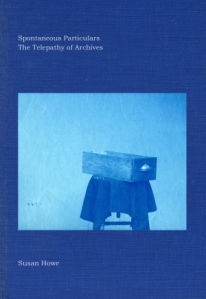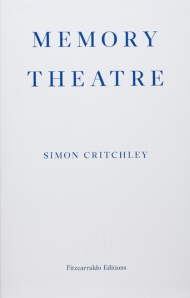Recently Read – Susan Howe & Simon Critchley
This edition of “Recently Read” features two books – both blue! – that are as delightful to read as they are to hold. Some books – particularly small books, I think – just feel right in the hand when the publisher has put extra care into the design and production. And today’s books come from publishers who do things right: the Christine Burgin imprint at New Directions and the new Fitzcarraldo Editions. Both are physically handsome, modestly sized, modestly priced, and short (80 and 68 pages respectively). Howe’s book comes hardbound with blue cloth covers and a reproduction of a cyanotype photograph pasted down on the cover. Critchley’s book has stiff French wraps that open up to reveal indigo blue endpapers.
Spontaneous Particulars: The Telepathy of Archives by Susan Howe is the latest of several spectacular trade book productions from Christine Burgin that include Robert Walser’s Microscripts, A Little Ramble, and Thirty Poems and The Gorgeous Nothings: Emily Dickinson’s Envelope Poems. Spontaneous Particulars was “originally conceived as a lecture” and slide show that has been turned into a free-form, genre-busting essay illustrated with photographs of archival objects that Howe has had the opportunity to view in various research libraries. The photographs show manuscripts by William Carlos Williams, Emily Dickinson, Jonathan Edwards, Hart Crane, Charles Pierce, Noah Webster, and Gertrude Stein, plus several images that were used in Howe’s limited edition publication Frolic Architecture (which was released in a trade version called This That). Like everything Howe writes, Spontaneous Particulars is tender and rigorous at the same time, with her unique mix of the spiritual and the analytic. To my mind, Howe’s essays achieve the status of poems and this one is dedicated to the objects that show us the moment during which creative ideas are first transferred to paper – typed and hand-written manuscripts, doodles and scribbles. Physician William Carlos WIlliams often wrote parts of poems on the pages of prescription pads. But my favorites are the manuscript books of Jonathan Edwards written on “discarded semi-circular pieces of silk paper his wife and daughters used for making fans.” About these Howe writes: “Surface and meaning cooperate to keep alive in one process mastery in service, service in mastery.” (All of my posts on Susan Howe can be found here.)
“I am dying. That much was certain. The rest is fiction.” So begins Simon Critchley’s Memory Theatre, a books that meanders around the concept of the “memory theater” of sixteenth century Italian Giulio Camillo, who featured prominently in France Yates’ 1966 book The Art of Memory. Critchley – or, perhaps, “Critchley” – finds he has inherited a number of boxes left to him on the death of his teacher, the French philosopher Michel Haar. Among the papers are astrological charts accurately predicting the death dates of several philosophers, plus one that ominously predicts the day on which Critchley himself will die. With his own death date approaching, Critchley weaves dreams, hallucinations, autobiography, and doses of fiction into a fascinating prose piece on memory.
I peered through the magnifying glass at my destiny. The detail was fascinating. Working through the concentric circles, I moved from briefly noted events in my life that Michel couldn’t possibly have known about…I tried to resist looking through at the centre of the circle, with the date of my death. But there it was: “le 13 Juin, 2010, 1551h, Den Bosch, hémorragie cérébrale.” Cerebal haemorhage. OK. I was expecting lung cancer. But where the fuck was Den Bosch?
The book includes a sequence of photographs of a skyscraper under construction by the British artist Liam Gillick. The photographs appear in reverse sequence and so we effectively watch the building’s dismantling. I suppose that’s a metaphor for something, but I thought Gilliam’s concept was rather flat and the execution left something to be desired. The images are all reproduced on blank pages, suggesting that they aren’t meant to mingle with the text but to proceed in parallel with it.
Susan Howe. Spontaneous Particulars: The Telepathy of Archives. NY: Christine Burgin/New Directions, 2014.
Simon Critchley. Memory Theatre. London: Fitzcarraldo Editions, 2014.




